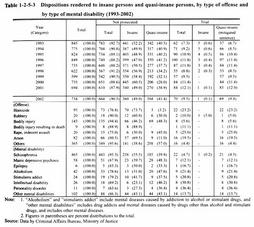| Previous Next Index Image Index Year Selection | |
|
|
2 Type of offense committed by insane persons or quasi-insane persons and type of mental disability they suffered Table 1-2-5-3 shows the trends in (a) the number of suspects who were not prosecuted by public prosecutors offices on the grounds of being insane or quasi-insane, (b) the number of persons who were found not-guilty on the grounds of being insane or given a mitigated sentence on the grounds of being quasi-insane in the first instance, over the last 10 years from 1993 to 2002, and (c) the dispositions in 2002 by type of offense and type of mental disability. In 2002, among 734 insane and quasi-insane persons, 436 were involuntarily admitted to mental hospitals, and 34 were sentenced to imprisonment without suspended sentence or taken into custody (see Appendix 1-11 ).
Among the 360 suspects who were not prosecuted on the ground of being insane in 2002, homicide had the largest share (70 persons), followed by bodily injury (66 persons), and arson (57 persons), by type of offense, and schizophrenia had the largest share (258 persons) by type of mental disability. Among 304 suspects who were not prosecuted on the ground of being quasi-insane, bodily injury had the largest share (69 persons) by type of offense, and schizophrenia had the largest share (185 persons), followed by manic-depressive psychosis (28 persons) by type of mental disability. Among the 69 convicts who were given a mitigated sentence on the ground of being quasi-insane ,persons in the first instance in 2002, homicide had the largest share (22 persons), and schizophrenia had the largest share (21 persons), followed by alcoholism (9 persons). Table 1-2-5-3 Dispositions rendered to insane persons and quasi-insane persons, by type of offense and by type of mental disability (1993-2002) |
